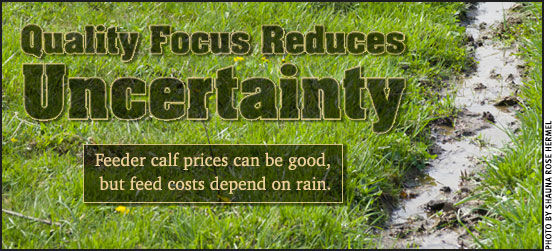Record-high calf prices don’t necessarily mean record-high profits in the beef business. Scott Brown, University of Missouri (MU) livestock economist, said rising feed costs will cut into cattle profits.
“Cattle producers should hope for a big corn acreage this spring, with rain in June and July. Also, hope for continued recovery in the general economy,” Brown told Dallas County, Missouri, cattle producers. “As more people get jobs, that creates more demand for beef.”
To show the difficulty for an economist to predict prices, Brown reminded listeners of 2012. “Remember, as late as May last year, USDA was predicting corn prices at $4.60 per bushel. Recently, corn was at $7.40 per bushel.” Read more.

Radale Tiner
Association Perspective
Time to retire the old bull.
With the market price of old bulls at an all-time high, this is the perfect time to trade in your old bull for a new, younger Angus bull. Many commercial cattlemen in recent times have been able to sell their older bulls for approximately the same price that the bulls were purchased for five to 10 years ago. These are definitely unprecedented times in the cattle industry. Read more.
What Are Our Consumers Telling Us?
The beef industry needs to address the issues consumers care about.
There are three important T’s to consider when the beef industry communicates with consumers, said John Lundeen, senior executive director of market research at the National Cattlemen’s Beef Association (NCBA). Those words are technology, trust and transparency. Lundeen shared remarks during the International Livestock Congress (ILC) Jan. 15 in Denver.
He noted that research continues to show that the majority of people love beef. However, we can’t ignore that some consumers want to know more about how beef is raised and have concerns, he added.
“We must answer the questions consumers ask,” Lundeen said. He pointed out that often we try to assure consumers about their concerns by focusing on science and technology. For example, we convey to consumers that modern farming is critical to feeding the world’s growing population, and modern farming is critical to keep food affordable for everyone. Read more.
Research to Create More Alternative Fuel
Texas A&M AgriLife Research gets grant to crack biofuel production
waste issue.
A scientist with Texas A&M AgriLife Research has begun work on a way to “engineer” a microbe to break lignin into lipid, which can then be used to make more fuel.
The project, which received a $2.4 million grant from the U.S. Department of Energy, could help solve the challenge of biowaste generated in biofuel production, according to Joshua Yuan of College Station, AgriLife Research plant pathologist and lead researcher on the project. Read more.
President Signs American Taxpayer
Relief Act into Law
H.R. 8 directly impacts U.S. agriculture.
The U.S. House of Representatives and the U.S. Senate passed the American Taxpayer Relief Act of 2012 (H.R. 8) prior to the president signing the legislation into law on Wednesday, Jan. 2, 2013. The legislation has direct implications on farm and ranch families, according to Missouri Cattlemen’s Association (MCA) Executive Vice President Mike Deering.
“It was essential that something was passed so farmers and ranchers may know what the year to come will hold,” said Deering. “Many agriculturists were waiting on the outcome of this bill so they could plan their next move.” Read more.
What’s Inside …
In this January edition of the Angus Beef Bulletin EXTRA, you'll find valuable articles devoted to the management, marketing, and health and nutrition of your beef enterprise. Select from the tabs at the top of the page to access this month's entire offering by category. A few select features include:
- Cow Temperament Affects Reproduction
- Beef Talk: It’s all about DNA
- Beef Cattle Winter Water Needs Complicated this Year
- A Warm Bath Can Do the Trick
- Pneumonia in Calves
- In the Markets
- Cargill Closes Texas Plant
News Briefs …
The American Angus Association and its subsidiaries generate a wealth of information to keep members and affiliates informed of what's happening within the industry as well as with the programs and services they offer. Click here for easy access to the newsrooms of the American Angus Association and Certified Angus Beef LLC and the Angus e-List archive recently made available in the API Virtual Library.
Bulletin for Safety
University bulletin outlines personal protective equipment for farm, ranch safety.
A new University of Wyoming (UW) Extension publication offers suggestions to ranchers and farmers purchasing and using personal protective equipment (PPE).
Every day, 243 agricultural workers in America suffer serious lost-work-time injuries, and 5% of these injuries result in permanent impairment, according to the Occupational Safety and Health Administration (OSHA).
“In 2010, the injury rate for agricultural workers was 20% higher than the rate for all workers,” said Randy Weigel, UW Extension human development specialist. “Many farm and ranch injuries could be prevented or their impacts reduced if they wore proper personal protective equipment.” Read more.
![]()
Tips to Promote Successful Aging
CSU researcher aims to optimize aging experience for graying population.
How does a person know when he or she is old? The answer is more complicated than one might think. Manfred Diehl, a Colorado State University (CSU) researcher in human development and family studies, is working to unravel the complicated interaction between how young or old a person feels — self-perceived age — and his or her actual age, and the impacts of both on health, well-being and quality of life as we age.
In a project funded by the National Institutes of Health, CSU is developing a measurement of self-perceived age that could lead eventually to an educational intervention to counteract negative perceptions about growing older.
Diehl offers his top tips to optimize the positives of aging. Read more.
[Click here to go to the top of the page.]














